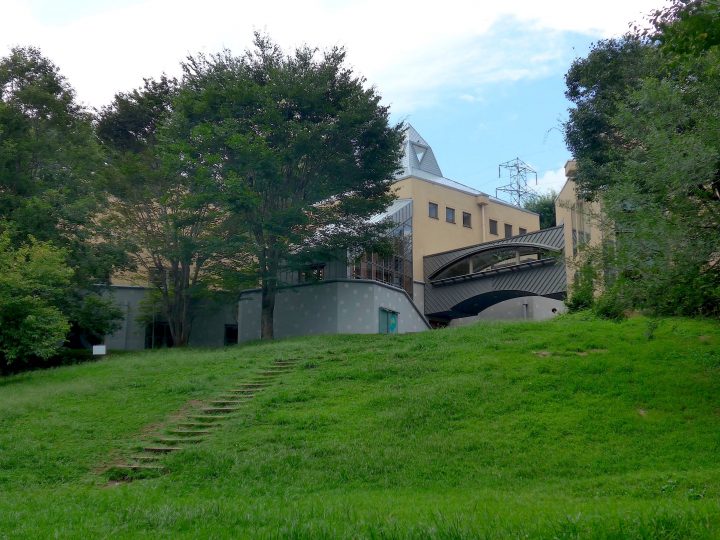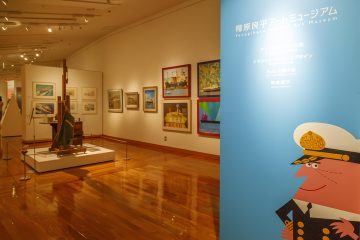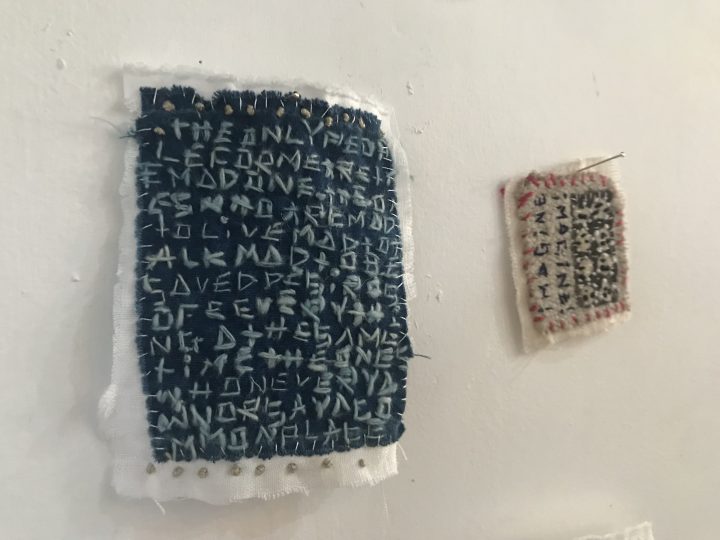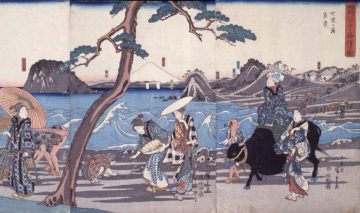"56th Venice Biennale International Art Exhibition" Report Part 1
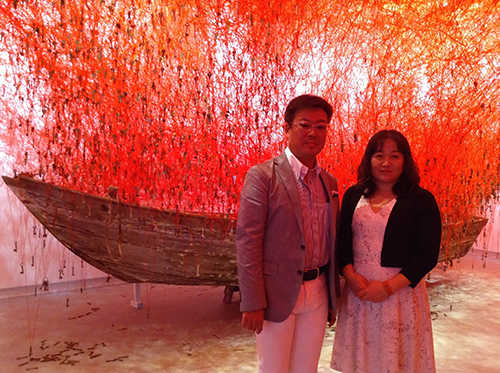
"Japan Pavilion - Shiota Chiharu's The Key in the Hand - Opening! An interview with Shiota Chiharu and Nakano Hitoshi"
Memories of the key, connected by a red thread
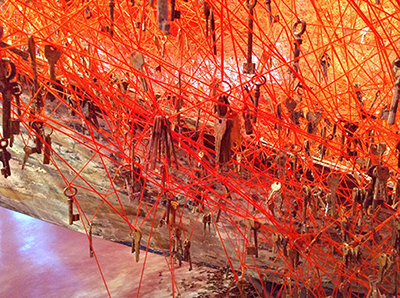
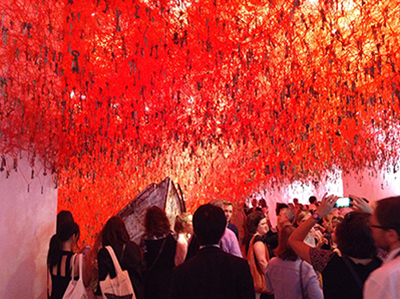
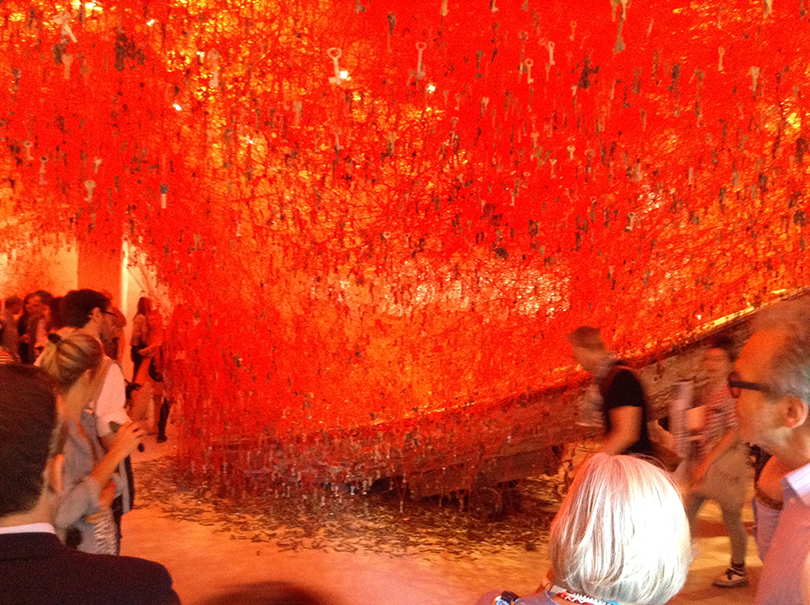
56th Venice Biennale International Art Exhibition Japan Pavilion Exhibition View (Exhibition Room)
--First of all, looking back from the day when it was decided that you would participate in the Venice Biennale to today's pre-opening, I'd like to ask you if there is a most memorable interaction or incident that occurred during your collaborative work.
Shioda : A collaboration between two people (laughs)?
Nakano : That's... the last week, right? But this might be a pretty deep conversation (laughs).
Shioda : ...There are so many things I can't say (laughs).
--I would appreciate it if you could answer with the assumption that some people will be reading it in the afternoon (laughs).
Shioda : Not that one, not that one (laughs)! We're both married and have children...
Nakano : (laughs)...Even before the decision was made, we had many busy days in contact via Skype, but after the decision was made, the first thing we did was to collect the keys.
--Your initial goal was to get 50,000 keys, but did you collect them all quickly?
Shioda : It didn't come together right away.
Nakano : Gradually. I got cooperation from locksmith associations and companies in Japan and Italy. Also, KAAT Kanagawa Arts Theatre, where I am currently working.
Shiota : When a locksmith makes a new key, the customer leaves the old key behind. We asked them to keep the key instead of throwing it away. We also received cooperation from the Japan Foundation in Japan, Germany, and Italy, the Museum of Art, Kochi, the Marugame City Genichiro Inokuma Museum of Contemporary Art in Kagawa, the 21st Century Museum of Contemporary Art, Kanazawa, Kyoto Art Center, Kyoto Seika University, the National Museum of Art, Osaka, the Kenji Taki Gallery, which has galleries in Nagoya and Tokyo, and art museums in the United States and Europe. Many of the keys we collected were sent with letters containing anecdotes related to the key, and we carefully store all of these letters in our atelier.
What was written in that letter?
Shiota : There were all kinds of keys and anecdotes, such as a key made for a mother with dementia who kept losing her keys, a key that her son had when he passed away while on a trip to Hokkaido, and keys that had accumulated over the course of moving house many times.
--In our last interview, we heard that the starting point of this exhibition was the death of someone close to you. Also, in the exhibition proposal, Nakano stated that this work confronts the fate of us humans, "life" and "death." In "Infinity" (a new work at the Espace Louis Vuitton Paris "Red Thread" exhibition), which was created in France just before Venice, light flashes like a heartbeat in a tunnel of black threads, making us think of souls heading to the underworld and the stars in the universe that are still reflected in our eyes even after their actual form has disappeared.
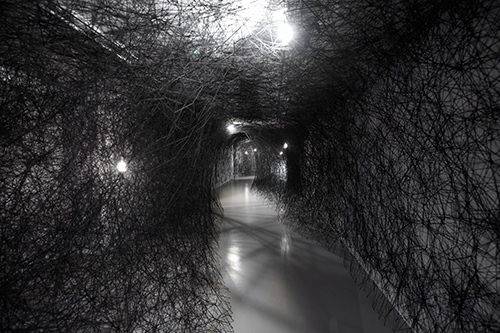
Chiharu Shiota, "Infinity," 2015. Photo courtesy of Espace Louis Vuitton Paris © Adagp, Paris 2015. Photo by Pauline Guyon.
--You mentioned earlier that some of the keys belonged to people who have passed away, but in the exhibition room, those keys looked like they were being released towards the future while being tied to a red thread. Please tell us again about the feelings you put into the act of tying the 180,000 old keys that were ultimately collected with the red thread while actually touching them.
Shiota : This exhibition made me think about the various meanings of keys. Holding a key is synonymous with having a chance. When you get a key, you can open a door that connects to a different world than the one in front of you. It's an opportunity to open your future with your own hands. On the other hand, losing a key can mean losing a part of your life. Keys are closely related to each person's life, and at the same time, their shape, made of a big head and a small body, makes them look like each individual human being. I thought that a red thread was the key to connect them. The red thread connects keys, that is, people, and weaves together the memories of the keys, that is, the memories of people.
--The theme of "the future" resonates with the overall theme of this year's Venice Biennale, "All the World's Futurs," set by Okwui Enwezor, the general director of the festival.
Nakano : In recent years, Japan has suffered the Tohoku earthquake and the nuclear power plant accident, but looking back at human history, we humans have overcome not only natural disasters, such as smallpox and the plague, but also other difficulties such as these epidemics with wisdom. That is why, together with Chiharu, I wanted to challenge myself to use art as an expression to look ahead to the "future" that we will entrust to our children, based on the universal theme of humanity, "life" and "death." In front of the box-shaped temporary wall in the piloti on the lower floor, there is a photo of a child's palm holding a key. Behind it, a video work "How did you come to this world?" is being screened on four monitors, in which children talk about what they remember from before they were born, that is, when they were in their mother's womb. This not only shows that they are the ones who have been entrusted with the key by their ancestors and will open the future, but also makes us think that they also bear social responsibility for the future.
Shiota : But this concept happened to be connected to the theme of Enviso.
Nakano : It was a coincidence, sorry (laughs). His theme was announced last fall.
A "demon" living in Venice? The "Olympics of Art" and its scene
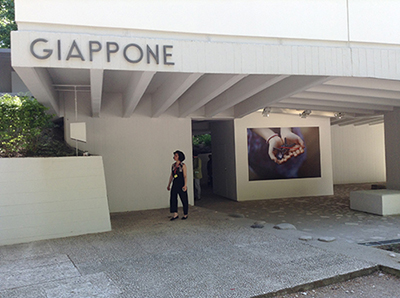

56th Venice Biennale International Art Exhibition Japan Pavilion Exhibition View (Pilotis)
--After being selected as representatives, you two visited the 14th International Architecture Exhibition of the Venice Biennale last year shortly after it opened, and carefully observed the architectural structure of the Japan Pavilion.
Nakano : As with the exhibitions we've created together with Chiharu, we decided on the composition of the exhibition while considering the nature of the building and space in the first place, without changing the characteristics of the exhibition room. Also, rather than just showing it, I think it's important for contemporary artists and curators to think about what kind of story they can tell there, or whether they can project contemporary issues.
--How many times did you inspect the venue before attempting to install your work?
Shiota : I came almost every month. It takes just under two hours by plane from Berlin, so I could come for a day trip. I also came at my own expense in addition to meetings. Since I use the space, I have to get used to the space, and I tried many times to see where and how to place what I want to convey when people enter the space. Because making a model is different from making a work on site.
Nakano : I have been there three times: at the opening of the architecture exhibition, in January of this year for a technical meeting, and in April for the installation of the work. During this installation, I made final adjustments with the artist, checking the feeling, movement, and viewpoint. Including this opening, there have been a total of four times.
Shiota : During the last week, we closed the venue so that only myself, one assistant, and Nakano could enter. My assistant has been with me for 16 years, so we can work in perfect harmony. I didn't want anyone else to enter the venue except for her. Otherwise I couldn't concentrate on the work. Unlike a museum or gallery, there are so many different people coming and going.
Nakano : I mainly work outside, and sometimes I come back to the venue and share my thoughts. Because the artist works in the exhibition room all the time, there are things that can be seen and things that can't be seen. At that time, from the position of a curator, it feels like I can cast a different perspective from the artist.
--Did any clashes of opinions occur in a closed space?
Shioda : No, there wasn't.
Nakano : "Chiharu-san, in order for this key and this interval to be related, this width needs to be a little wider, right?" He calmly asks. This is the best part of collaboration between an artist and a curator.
--I believe it was during the period when your work was on display, but you mentioned on Facebook that artists and curators who had exhibited at the Japan Pavilion had told you that "there are demons in Venice." Were there any "demons"?
Shiota : Yes there was (laughs)
Nakano : The Venice Biennale is the so-called "Olympics of Art," where pavilions from each country compete for prizes. On the other hand, while asking what determines the winner or loser of art, what is a success and what is 100 points, there is no such thing, and it doesn't matter, the tension of standing on the stage makes you unconsciously step on the accelerator more than usual. That was the kind of "demon" it was, now that I think about it...
Shioda : It's not a stage where the winner always wins. Some writers put in too much effort and end up collapsing.
Nakano : The important thing is the amount. It's not that a lot is good, but how you get it down to the right amount, but when the engine is running at full throttle it's easy to overdo it or lose sight of it.
Shiota : Ms. Uematsu (Yuka Uematsu, curator of the "Tabaimo: Teleco Soup" exhibition at the Japan Pavilion of the 54th Art Exhibition) also told me that "Venice is about subtraction, not addition." Think about what you want to show most and then cut it down.
Nakano : I previously wrote in the catalogue for the exhibition "From Silence" that "Shiota Chiharu does not add black threads to an empty space, but draws black from the pitch black darkness." This idea of "pulling" is very Japanese, and I realized once again that it is connected to the Zen idea of Kamakura Buddhism, which is to throw something away by sitting in meditation.
From Kanagawa to Venice: Future prospects and those who will open the doors of the Japan Pavilion
--After Venice, please tell us about your next new work or exhibition.
Shioda : Keys are a very complex material, so I would like to continue making works using keys in the future.
Nakano : I would like to do something with Shiota Chiharu, who gained attention at the Kanagawa Prefectural Hall Gallery and has grown significantly since then, such as holding another exhibition in Kanagawa.
--That must be something MAGCUL.NET readers and editorial staff are looking forward to.
Nakano : We don't have any plans yet, but I hope to make it happen together with the artists. Some readers of MAGCUL.NET may have seen Chiharu's participation in the "1st Yokohama Triennale" in 2001, or his largest solo exhibition "From Silence" (2007) at the Kanagawa Prefectural Hall Gallery. It started in Kanagawa, and through various subsequent efforts by artists, we have arrived at Venice today. First of all, I would like everyone to come to Venice to see our exhibition, which has been nurtured and matured by Kanagawa, during the exhibition period until November.
--I'm sure that some of our readers will be young Japanese artists or curators who will represent Japan at the Venice Biennale in the future. Could you give us a final message as a "key" to hand over to them?
Shiota : It was a great honor to have the opportunity to exhibit at the Japan Pavilion in Venice this time, and when it was decided, I thought it was good that I had done so far. I was able to create my work while thinking that it was fine to continue as I had done before, rather than doing something special at the Japan Pavilion. So, I don't think it's so much advice, but I think it's important to continue creating works. Another thing is meeting curators? I don't think you can suddenly take on a stage like Venice with someone you've never worked with before, so I think it's important to have many curators see and get to know you. I kept in contact with Nakano-san between exhibitions, so I was able to be selfish (laughs).
Nakano : I want young artists and curators to always look at themselves, know their position, and then become interested in a field that is the opposite of their own interests or a different world, and then look at themselves again from there. It can be physics, religious studies, or anything. By having another strength besides art and gaining a broad perspective, I think you can create and find works to present to society. Also, I want young artists to grow together while creating exhibitions with young curators.
Profile
Chiharu Shiota
Born in Osaka in 1972. Lives in Berlin.
Confronting the fundamental human issues of life and death, he explores questions such as "what does it mean to live?" and "what does it mean to exist?" while producing works that employ a variety of techniques, including large-scale installations, sculpture, photography, and video.
He received the Minister of Education, Culture, Sports, Science and Technology's Art Encouragement Prize for New Artists for his solo exhibition "From Silence" (2007) at the Kanagawa Prefectural Hall Gallery.
His major solo exhibitions include the Smithsonian Museum's Arthur M. Sackler Gallery (Washington DC / 2014), Mattress Factory (Pittsburgh / 2013), Kochi Museum of Art (2013), Marugame Genichiro-Inokuma Museum of Contemporary Art (Kagawa / 2012), Casa Asia (Barcelona / 2012), and the National Museum of Art, Osaka (Osaka / 2008). He has also participated in numerous international exhibitions, including the Kiev International Biennale of Contemporary Art, Setouchi Triennale, Aichi Triennale, Moscow Biennale, Seville Biennale, Gwangju Biennale, and Yokohama Triennale. http://www.chiharu-shiota.com/
Hitoshi Nakano
Curator at the Kanagawa Arts Foundation. Born in Kanagawa Prefecture in 1968.
Completed the master's course in Aesthetics and Art History at Keio University Graduate School.
Major projects include the performing arts musical poetry drama Ikutagawa Monogatari – Based on the Noh play “Kyotozuka” (creative contemporary Noh, 2004, Kanagawa Prefectural Music Hall), Alma Mahler and the artists of the fin de siècle Vienna (music and art, 2006, same), and John Cage’s 100th birthday: Time and space in conflict (music and dance, 2011, Kanagawa Prefectural Hall Gallery). In terms of contemporary art exhibitions, he has planned and produced Chiharu Shiota's "From Silence" (2007, Kanagawa Prefectural Hall Gallery), Taketo Koganezawa's "Between This and That" (2008, Kanagawa Prefectural Hall Gallery), "Everyday Life/Out of Place" (2009, Kanagawa Prefectural Hall Gallery), "Port of Design." Katsumi Asaba's Exhibition (2009, 2010, Kanagawa Prefectural Hall Gallery), Taro Izumi's "Kneading" (2010, Kanagawa Prefectural Hall Gallery), "Everyday Life/With a Reason" (2011, Kanagawa Prefectural Hall Gallery), Hiraki Sawa's "Whirl" (2012, Kanagawa Prefectural Hall Gallery), "Everyday Life/Off the Record" (2014, Kanagawa Prefectural Hall Gallery), Ryota Yagi's "Science/Fiction" (2015, Kanagawa Prefectural Hall Gallery), and other collaborations between installation works and performing arts. He is a researcher at the Institute of Arts and Resources Management. He is a part-time lecturer at Tokai University and Joshibi University of Art and Design.
▷ The Japan Foundation Venice Biennale Japan Pavilion website
Report author: Iida Mami (art historian)

